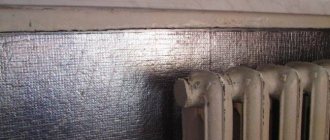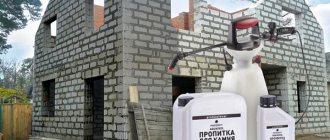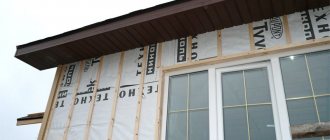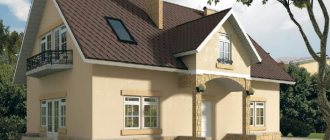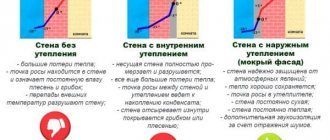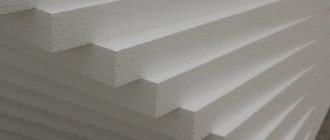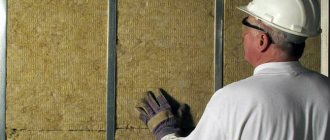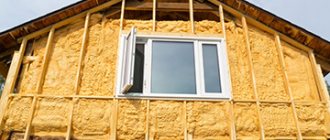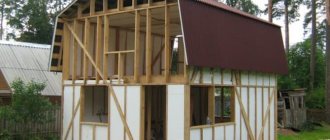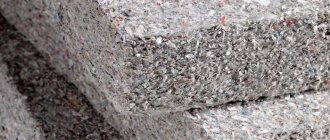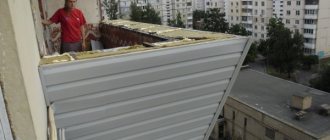Advantages of roll material
This material has many advantages. The main thing is that the insulation in rolls does a good job of maintaining optimal indoor temperatures. There are other advantages:
- easy installation;
- easy transportation to your destination;
- good adhesion to surfaces;
- resistance to destructive factors;
- relatively low cost;
- use of the material on objects for various purposes.
Main types of insulation
Thermal insulation in rolled rolls can be used both for external and internal laying. There are options specifically designed for pipes and communications. Roll insulation for walls directly under the wallpaper is also available for sale.
The raw materials used for their production are also different. Thermal insulation made from mineral components is the most common. Foamed polyethylene is also popular. Natural insulation materials like cork are less common and used. Some types have an additional layer in the form of foil or paper. Let's consider each option in more detail.
Characteristics of glass wool thermal insulation in roll form
Different manufacturers may have slightly different figures. However, when choosing insulation, pay attention to the following minimum values:
Material density – from 10 kg/m3 Thermal conductivity – from 0.37% Susceptibility to combustion – NG (non-flammable) Water absorption – from 16% Equilibrium humidity – from 3.4% Compressive stability – from 30 kPa. Scope of application of roll insulation Roll insulation can be used on a wide variety of surfaces. They will perfectly protect loggias and balconies, floors and ceilings. They are suitable for insulating homestead structures, basements and roofs. This material is very convenient for pipe insulation. High-quality insulation in the form of rolls will last up to 50 years, which is a good service life. You can carry out the installation yourself; you do not need the help of professionals. Because of this, such insulation materials are popular in construction on private plots; they are used to insulate bathhouses, outbuildings and other structures. It is not recommended to use rolled materials for insulating vertical coverings that are subject to high loads.
Note! Thermal insulation in the form of rolls is not suitable for insulating vertical surfaces that bear high loads.
Special thermal insulation coating
To improve the performance of their products, companies that produce rolled thermal insulation add certain coatings. The basis under them may be different.
- Foil has the property of reflecting heat. Basically, it is attached to one side, the one that will face the inside of the room. This will protect the walls from moisture. Initially, the technology was developed for warm pipes, but over time it began to be used for other surfaces. Foil insulation is produced by almost all well-known companies in this field.
- Metallized coating, it is different from the previous one with steam and breathability. But it has a drawback: due to mechanical influences, the layer decreases or completely disappears, which increases heat loss.
- Paper layer , which improves the adherence of rolls to the walls. It can be on one or both sides. The last option is used for subsequent wallpapering.
Types of mineral wool in rolls
There are several varieties of insulation in this group. Their structure is the same, they differ in composition.
- Basalt wool. This material is made by melting rocks into the finest fibers that are intertwined randomly. By adjusting the density of the material, manufacturers obtain hard or elastic wool. The latter is applicable for rolls. The thermal conductivity of the material is the lowest of all similar options. This allows it to be a fairly common type of insulation. The weight of one cubic meter of cotton wool ranges from 30 to 100 kg. The maximum temperature it can withstand is 700 degrees. Manufacturers claim that the basalt components of cotton wool are safe for health. However, over time, particles of fibers and binders are found in the air.
- Glass wool. The same fibers are melted, but using glass waste . It has the lowest cost and density up to 25 kg/m³. It can withstand high temperatures, its maximum is about 450 C°. The above indicators destroy glass wool thoroughly. She copes with her main task well. A negative feature is the impact on the respiratory tract and skin during installation and operation. Therefore, thermal insulation made of glass fibers is mainly relegated to the role of only the outer layer.
- Slag-like. The third type of insulation is made from metallurgical waste (blast furnace slag). The price of rolls is also reasonable. However, this type of cotton wool is outdated; it was popular back in the USSR. Due to the fragility and allergenicity of the fibers, it is not used in residential areas. The density of the material is different: wool with an indicator of 75 kg/m³ is used for floors, 125 kg/m³ is suitable for walls. It is highly hygroscopic and loses its properties when wet. Not flammable, melts at temperatures above 300 C°.
Any type of wool must be covered with a vapor barrier, especially in rooms with high humidity. And it also holds back the smallest particles of fibers that appear over time and negatively affect a person. Raw materials often contain formaldehyde, which also affects health. High-quality rolls should have a minimum of this substance
Before laying mineral wool, a frame must be installed. On the walls, the panels that hold it in place are pressed firmly so that the canvas does not move out over time. For the necessary protection from the cold, the number of layers can be increased.
Manufacturers often divide their products according to the purpose of the insulation. For ceilings and floors, the rolls will be lighter. For the main floor, walls, and other surfaces, the density of the material is usually increased. Due to this, the dimensions of the roll also change:
- length from 3 to 8 meters;
- thickness in 3 options (50 mm, 100 mm, 150 mm);
- width from 0.6 m to 1.22 m.
Kinds
The material is divided by purpose: for roofing, flooring, walls. If desired, you can purchase a universal one designed for various surfaces.
Manufacturers offer two types of insulation:
- based on cotton wool (basalt, glass, slag wool);
- foil based on foamed polymers and mineral wool.
The latter is approximately 10% more expensive than the usual one, but at the same time surpasses it in performance characteristics. Has water-repellent characteristics. Foil reflects heat (approximately 97%) back into the room, makes the product more elastic, and facilitates the installation process.
Manufacturers of insulating wool
Construction stores offer a wide selection of mineral wool. Let's look at the features of materials from some companies specializing in this area:
- Isover. This manufacturer produces mainly glass wool, which has decent characteristics. The materials are breathable and recover their shape well after mechanical stress. They do not emit harmful substances when heated. However, when installing any type of mineral wool, it is necessary to use personal protective equipment . Options for roofs have high protection against moisture and good sound insulation. Cotton wool of the “Sauna” brand (for baths and other wet rooms) has an aluminum coating, reinforced with reinforced mesh, which makes it possible not to use a vapor barrier.
- Ursa. Both universal and specialized glass wool is produced under this brand. For example, for hot pipelines or equipment heating up to 270 degrees. The manufacturer also offers a product with Pure one technology. It allows you to bend around irregularities due to the “spring” effect. The binder for the raw material is safe acrylic, which prevents the fibers from breaking. It is a good option for rooms with children.
- Rockwool. Produces durable basalt wool for technical use, which can withstand temperatures of 1000 C°. It is environmentally friendly and does not lose its thickness over time, as the manufacturer claims.
Foamed roll insulation for roof
Among the roll insulation for roofing, there are also fully polymer ones available, which look like a substrate for a laminate. In most cases this is:
- penofol (foamed polyethylene) with a layer thickness of 3–10 mm, which can be supplied with single- and double-sided foil and an adhesive layer;
- penotherm (foamed polypropylene) 6–10 mm thick, with or without foil.
Products with similar properties and composition are also produced by the brands “Izolon”, “Alufom”, “Polifom”, “Jermaflex”, “Ekofol” and others.
These materials are extremely thin, but in combination with foil they can provide reliable thermal insulation of the attic. Their light weight and thin thickness make them great for owners of older homes who are not ready to reinforce the roof and foundation structure. Foamed polymers are completely safe during installation, and thanks to the coating made of pure aluminum, they are not able to emit any harmful substances into the atmosphere of the attic. The material simultaneously serves as heat, moisture and sound insulation; no films or membranes need to be installed with it. Penofol is also used when the ceiling height is critically low. To maintain the height of the attic, you don’t even need to cover it with finishing; the foil ceiling will look unusual and futuristic.
At the same time, penofol and penotherm can be used in combination with any other types of insulation, from mineral wool to fiberboard . Such a multi-layer cake will improve your thermal insulation several times, and foam insulation costs no more than a good waterproofing membrane.
The only drawback of foamed heat insulators is their low heat resistance; they begin to collapse when heated to 91o C.
Foamed polyethylene for insulation
Has many positive qualities. It is obtained by filling heated polyethylene with gases. As a result, a mass is formed with many closed bubbles inside, which subsequently hardens. For special strength, it is also “cross-linked,” i.e., the bonds of molecules are strengthened chemically.
two options on sale . Both types have very low thermal conductivity, but the first one still has better characteristics, and therefore costs more (its density is 30 kg/m³). The general properties of the materials are:
- they are durable;
- absolutely do not absorb water;
- easy to install;
- do not harm the environment and humans;
- they are not afraid of organic destroyers such as bacteria and fungi;
- The layer thickness required to retain heat is much smaller than, for example, mineral wool.
The difference is that cross-linked polyethylene foam is capable of absorbing sounds well, but its brother cannot boast of this. It works worse as a sound insulator. Under mechanical stress, the uncrosslinked version loses its shape irrevocably. Cross-linked has greater compressive strength, which means it can be used for insulating horizontal surfaces.
Due to the thinness of the material, rolls can be up to 30 meters in length, width from 0.6 to 1.2 m. Thickness reaches 1 cm. Negative nuances for polyethylene are flammability and current conductivity (electricity passing nearby must be well insulated) . To secure the material to the wall, special glue is required.
Choosing insulation for a pitched roof
The market for modern building materials offers a huge number of all kinds of thermal insulation materials of various origins, manufactured using a variety of technologies.
To determine the appropriate insulation for a pitched roof, it is worth considering the following indicators:
- Low thermal conductivity, no more than 0.05 W/m×K.
- Minimum weight so as not to overload the roof. To determine the mass of a heat-insulating material, it is enough to know its density. For insulation based on mineral wool, 45-50 kg/m3 is sufficient, and for fiberglass - 14 kg/m3.
- The material must have water-repellent properties. If it gets wet, it will lose up to 60% of its beneficial qualities.
- Resistance to sudden temperature fluctuations, including severe frosts and various natural influences, which seriously affects the durability of the material.
- Environmental cleanliness - namely, the release of harmful substances into space during operation.
- Fire safety. It is very good if such material does not burn and does not support combustion.
- The ability to retain its shape for a long time, which affects the quality indicators of the thermal insulation layer.
- Durability. Modern thermal insulation materials are distinguished by enviable durability. Insulation for a pitched roof must have a service life of at least 50 years.
The following modern insulation materials satisfy similar requirements:
- Mineral wool produced on the basis of basalt rocks: PAROC, eXtra, ROCKWOOL Light BUTTS, ROCKWOOL Light BATTS SCANDIC, ISOROC ISOLIGHT, TECHNOLIGHT Extra, TECHNO Rocklight.
- Mineral wool produced on the basis of fiberglass: URSA Pitched roof, ISOVER Pitched roof, ISOVER Roll frame - M40-TWIN-50, KNAUF Pitched roof Thermo Roll-037, KNAUF COTTAGE Thermo Roll-037, KNAUF COTTAGE Thermo Plate-037.
- Expanded polystyrene (foam plastic) is suitable for insulating non-residential attic spaces. It is laid on the floor and then filled with cement-sand screed. This is due to the fact that the material burns and releases a whole list of harmful substances.
- Extruded polystyrene foam, like PENOPLEX, is also used in conditions where there is no contact with fire (presumably).
- Polyurethane foam is insulation in liquid form. It is used by spraying or filling free space.
It is worth noting that almost all cotton wool, of any origin, absorbs moist air. In this regard, the installation of such insulation is accompanied by the installation of special waterproofing films. Regular polystyrene or extruded polystyrene foam is also used as insulation for pitched roofs, although many experts do not recommend this.
This list includes some of the most popular insulation materials of our time. At the same time, one should not discount environmentally friendly insulation based on natural materials, such as seaweed, roof insulation based on flax, straw, hemp, as well as cork. Practically, all of them are flammable, although there is one advantage - they do not emit toxic substances when burning.
Therefore, it makes sense to consider the most well-known and affordable methods of insulating pitched roofs based on modern insulation materials.
Penofol brand polyethylene foam
Penofol insulation appeared recently, but has already stood out among its peers. It is not destroyed by weather conditions and aggressive environments. Thermal insulators of this company have several varieties:
- the foil covering can be fixed on one or both sides;
- rolls with an adhesive layer (even more simplifies installation);
- specialized type of insulation for communication networks;
- insulation for harsh conditions with a thickness of up to 40 mm.
The combined technology makes it possible to further reduce the thermal conductivity of insulated surfaces. A moisture-resistant and durable material that does not require the cost of vapor barrier, can be used in various directions. Does not lose its properties in the temperature range from -60 to +100 C°.
